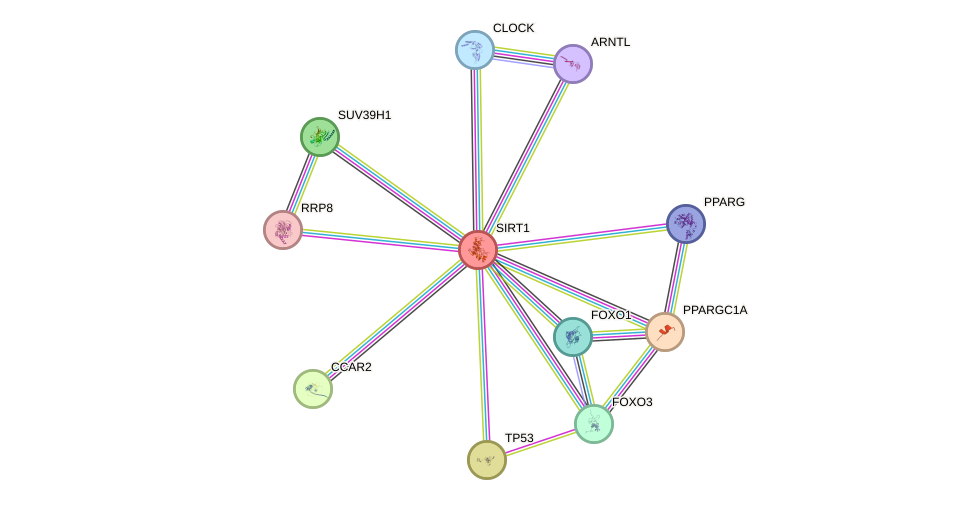GenAge entry for SIRT1 (Homo sapiens)
Entry selected based on evidence directly linking the gene product to ageing in a mammalian model organism
Gene name (HAGRID: 150)
- HGNC symbol
- SIRT1
- Aliases
- SIR2L1
- Common name
- sirtuin 1
Potential relevance to the human ageing process
- Main reason for selection
- Entry selected based on evidence directly linking the gene product to ageing in a mammalian model organism
- Description
SIRT1 is a NAD-dependent deacetylase, which can regulate a number of processes by deacetylating key proteins, such as TP53 [734]. In yeast, the SIRT1 homologue sir2 has been linked to cellular senescence [200]. Increasing the levels of SIRT1 homologues in fruit flies [1284] and roundworms [199] extends lifespan, although these findings have been questioned by other studies [3321].
SIRT1-null mice are born smaller than controls with evidence of developmental retardation. Depending on their genetic background, SIRT1-null mice either die shortly after birth or reach adulthood, the latter being smaller than controls and sterile [201]. Additionally, SIRT1-null mice utilize ingested food inefficiently, are hypermetabolic, contain inefficient liver mitochondria, have elevated rates of lipid oxidation and do not display an extended lifespan under caloric restriction [3608]. Heterozygous mice had a normal average lifespan [1922]. Mice with moderate overexpression of SIRT1 exhibit fat mass gain similar to controls exposed to a high-fat diet [1897]. Cardiac-specific low to moderate overexpression of SIRT1 attenuated age-dependent increases in cardiac hypertrophy, apoptosis, and expression of senescent biomarkers while a high level of overexpression had detrimental effects and induced cardiomyopathy [1930]. Overall, whole-body moderate overexpression of Sirt1 improves healthy ageing but does not increase mice lifespan [3266]. Brain-specific overexpression in mice results in moderately longer lifespan as females live 16% longer and males 9% longer [3268].
SIRT1 is overexpressed in calorie restricted rats, a response attenuated by insulin (INS) and IGF1 [1328]. Increased dosage of SIRT1 in pancreatic beta cells enhanced INS secretion [1481].
In Cockayne syndrome, an accelerated ageing disease, activation of SIRT1 through a high-fat diet and NAD(+) supplementation results in the rescue the mice from the associated progeroid phenotypes [3605]. In murine induced pluripotent stem cells, SIRT1 is necessary for telomere elongation after reprogramming and is required to maintain genomic stability, telomeric transcription and remodeling of telomeric chromatin. SIRT1-deficient induced pluripotent stem cells accumulate chromosomal aberrations and show a derepression of telomeric heterochromatin [3606]. In humans, increased levels of SIRT1 and SIRT3 have been associated with frailty [3607]. Although SIRT1 could impact on age-related diseases, such as type 2 diabetes, further studies are needed to establish its role in human ageing.
Cytogenetic information
- Cytogenetic band
- 10q21.3
- Location
- 67,884,669 bp to 67,918,390 bp
- Orientation
- Plus strand
Protein information
- Gene Ontology
-
Process: GO:0000012; single strand break repair
GO:0000122; negative regulation of transcription from RNA polymerase II promoter
GO:0000183; chromatin silencing at rDNA
GO:0000720; pyrimidine dimer repair by nucleotide-excision repair
GO:0000731; DNA synthesis involved in DNA repair
GO:0001525; angiogenesis
GO:0001542; ovulation from ovarian follicle
GO:0001678; cellular glucose homeostasis
GO:0001934; positive regulation of protein phosphorylation
GO:0001938; positive regulation of endothelial cell proliferation
GO:0002821; positive regulation of adaptive immune response
And 132 more GO terms Cellular component: GO:0000790; nuclear chromatin
GO:0005634; nucleus
GO:0005635; nuclear envelope
GO:0005637; nuclear inner membrane
GO:0005654; nucleoplasm
GO:0005677; chromatin silencing complex
GO:0005719; nuclear euchromatin
GO:0005720; nuclear heterochromatin
GO:0005730; nucleolus
GO:0005737; cytoplasm
GO:0005739; mitochondrion
And 6 more GO terms
Show all GO termsFunction: GO:0001046; core promoter sequence-specific DNA binding
GO:0001077; transcriptional activator activity, RNA polymerase II core promoter proximal region sequence-specific binding
GO:0002039; p53 binding
GO:0003714; transcription corepressor activity
GO:0003950; NAD+ ADP-ribosyltransferase activity
GO:0004407; histone deacetylase activity
GO:0005515; protein binding
GO:0008022; protein C-terminus binding
GO:0008134; transcription factor binding
GO:0017136; NAD-dependent histone deacetylase activity
GO:0019213; deacetylase activity
And 15 more GO terms
Protein interactions and network
- Protein-protein interacting partners in GenAge
- TP53, WRN, E2F1, STAT3, IRS1, IRS2, AKT1, MYC, NCOR1, NBN, JUND, FOS, PPARA, PARP1, HSP90AA1, UBE2I, STK11, EP300, PML, AR, RB1, FOXO3, FOXO1, HSF1, RECQL4, RELA, SIRT1, HSPA9, HSPD1, MAPK8, JUN, FOXO4, PIK3R1, CREB1, APEX1, CDK1, MAPT, HDAC2, ESR1, MTOR, CTNNB1, CHEK2, ARNTL, CLOCK, HIC1, PPARGC1A, TP73, RICTOR
- STRING interaction network
Retrieve sequences for SIRT1
Homologs in model organisms
- Caenorhabditis elegans
- sir-2.1
- Danio rerio
- sirt1
- Drosophila melanogaster
- Sir2
- Mus musculus
- Sirt1
- Rattus norvegicus
- Sirt1
In other databases
- GenAge model organism genes
- GenDR gene manipulations
- LongevityMap
- This gene is present as SIRT1
- CellAge
- This gene is present as SIRT1

